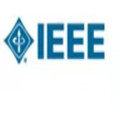We present a novel approach based on artificial neural networks, so-called geodesyNets, and present compelling evidence of their ability to serve as accurate geodetic models of highly irregular bodies using minimal prior information on the body. The approach does not rely on the body shape information but, if available, can harness it. GeodesyNets learn a three-dimensional, differentiable, function representing the body density, which we call neural density field. The body shape, as well as other geodetic properties, can easily be recovered. We investigate six different shapes including the bodies 101955 Bennu, 67P Churyumov-Gerasimenko, 433 Eros and 25143 Itokawa for which shape models developed during close proximity surveys are available. Both heterogeneous and homogeneous mass distributions are considered. The gravitational acceleration computed from the trained geodesyNets models, as well as the inferred body shape, show great accuracy in all cases with a relative error on the predicted acceleration smaller than 1\% even close to the asteroid surface. When the body shape information is available, geodesyNets can seamlessly exploit it and be trained to represent a high-fidelity neural density field able to give insights into the internal structure of the body. This work introduces a new unexplored approach to geodesy, adding a powerful tool to consolidated ones based on spherical harmonics, mascon models and polyhedral gravity.
翻译:我们展示了一种基于人工神经网络的新颖方法,即所谓的大地测量网,并提供了令人信服的证据,证明它们有能力利用关于身体的原始信息,作为高度不正常的机体的精确大地测量模型。该方法并不依赖身体形状信息,但可以加以利用。大地测量网可以学习代表体密度的三维、不同功能,我们称之为神经密度场。身体形状以及其他大地测量特性可以很容易地恢复。我们调查了六种不同的形状,包括101955年Bennu、67P Churyumov-Gerasimenko、433Eros和25143 Itokawa等机构,这些机构在近距离调查期间开发的形状模型是可供使用的。考虑的是混杂和同质质量分布。从训练有素的大地测量网模型和推断体形状中计算出的重力加速,在所有情况下,在预测加速速度小于1 ⁇ (甚至接近小于小于小行星表面)的加速度上都显示非常精确性。当有组织形状信息可用时,大地测量网络可以无缝地利用它,从而将高密度引入一个高度的直径结构结构结构。这代表了一种高度的直观,从而可以引入了一种高度结构。





